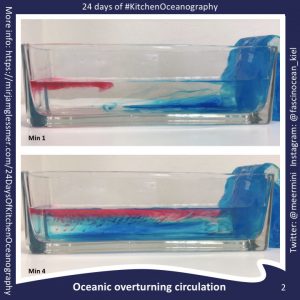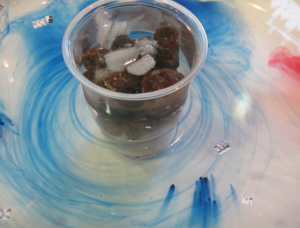
Tag: circulation


Combining a slowly rotating water tank with a temperature gradient: A thermal wind demonstration!
Setting up an overturning circulation in a tank is easy, and also interpreting the observations is fairly straightforward. Just by introducing cooling on one side of a rectangular tank a…

Experiment: Temperature-driven circulation
My favorite experiment. Quick and easy and very impressive way to illustrate the influence of temperature on water densities. This experiment is great if you want to talk about temperature…

Those foam stripes parallel to the coast — again!
I think I might be getting obsessed with those stripes parallel to the coast. We saw them as foam stripes, eel grass stripes and now today: leaf stripes! Or should it…

The importance of playing in outreach activities.
Some time ago, I wrote two blog posts on the importance of playing in outreach activities for the EGU’s blog’s “educational corner” GeoEd. Both have now been published, check them…

Continuity
What do you see when you look at an aquarium? When I was in Gothenburg last year for EMSEA14, one night we got to hang out at the Sjöfartsmuseet Akvariet there,…

Eddies in a jar
Rotating experiments in your kitchen. Do you know those Saturday mornings when you wake up and just know that you have to do oceanography experiments? I had one of those…

Hadley cell experiment
Cooling and rotation combined. (deutscher Text unten) I can’t believe I haven’t blogged about this experiment before now! Pierre and I have conducted it a number of times, but somehow…

Langmuir circulation, take 2
Attempt at mechanistic understanding of Langmuir circulation. After complaining about how I didn’t have mechanistic understanding of Langmuir circulation recently, and how I was too lazy to do a real literature…

Water seeks its level.
A solution for the siphon problem of the fjord circulation experiment. After having run the fjord circulation experiments for several years in a row with several groups of students each…

Fjord circulation
Tank experiment on a typical circulation in a fjord. Traditionally, a fjord circulation experiment has been done in GEOF130’s student practicals. Pierre and I recently met up to test-run the…

Langmuir circulation
We think we observed Langmuir circulation, but we don’t understand the mechanism causing it. Recently, my friend Leela came to visit Bergen and we went on a fjord cruise to…